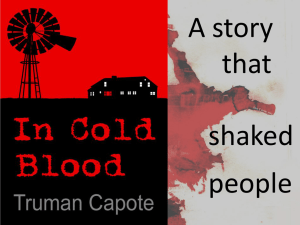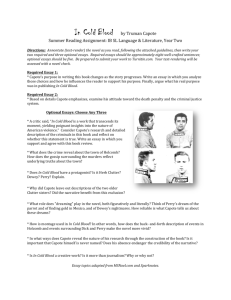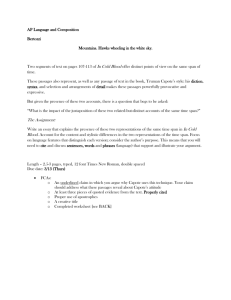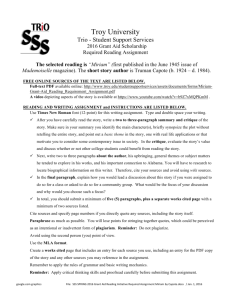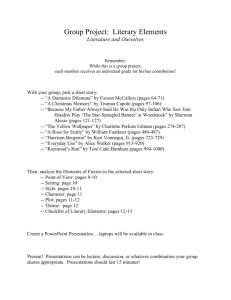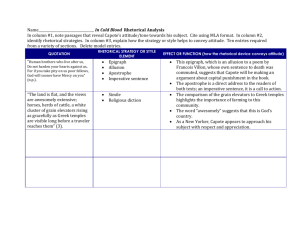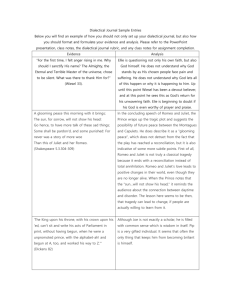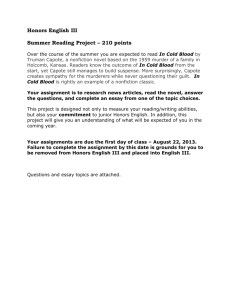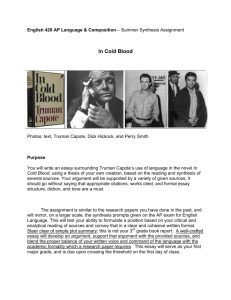Johnson HS IB Summer Reading 2015
advertisement
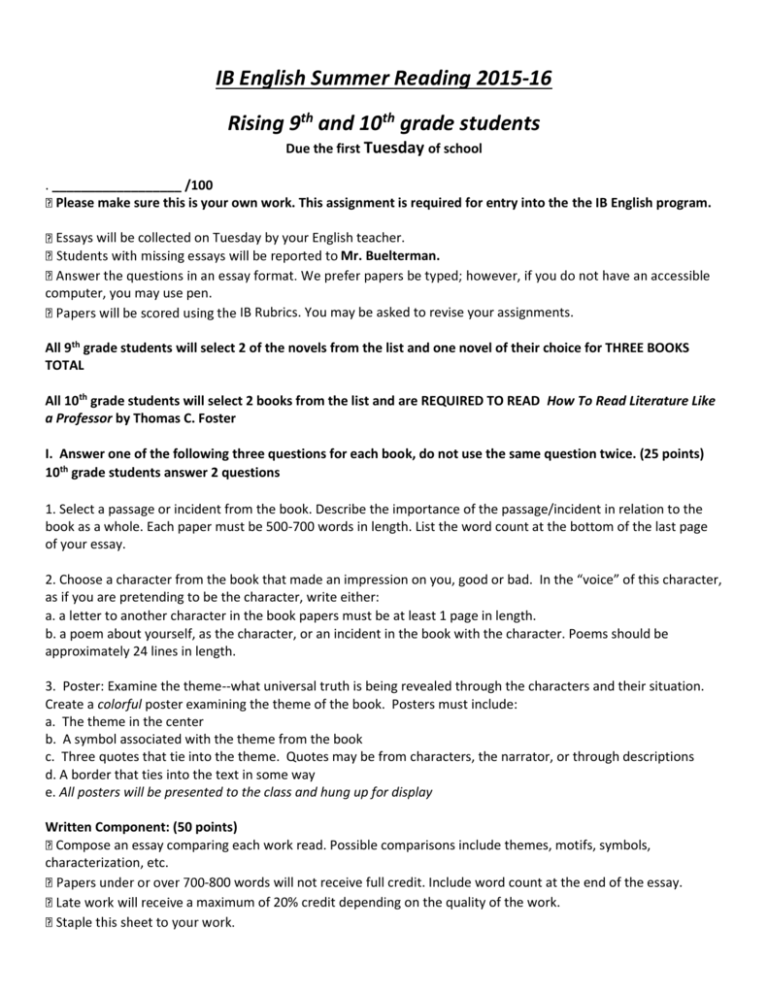
IB English Summer Reading 2015-16 Rising 9th and 10th grade students Due the first Tuesday of school . __________________ /100 Please make sure this is your own work. This assignment is required for entry into the the IB English program. Essays will be collected on Tuesday by your English teacher. Mr. Buelterman. computer, you may use pen. IB Rubrics. You may be asked to revise your assignments. All 9th grade students will select 2 of the novels from the list and one novel of their choice for THREE BOOKS TOTAL All 10th grade students will select 2 books from the list and are REQUIRED TO READ How To Read Literature Like a Professor by Thomas C. Foster I. Answer one of the following three questions for each book, do not use the same question twice. (25 points) 10th grade students answer 2 questions 1. Select a passage or incident from the book. Describe the importance of the passage/incident in relation to the book as a whole. Each paper must be 500-700 words in length. List the word count at the bottom of the last page of your essay. 2. Choose a character from the book that made an impression on you, good or bad. In the “voice” of this character, as if you are pretending to be the character, write either: a. a letter to another character in the book papers must be at least 1 page in length. b. a poem about yourself, as the character, or an incident in the book with the character. Poems should be approximately 24 lines in length. 3. Poster: Examine the theme--what universal truth is being revealed through the characters and their situation. Create a colorful poster examining the theme of the book. Posters must include: a. The theme in the center b. A symbol associated with the theme from the book c. Three quotes that tie into the theme. Quotes may be from characters, the narrator, or through descriptions d. A border that ties into the text in some way e. All posters will be presented to the class and hung up for display Written Component: (50 points) Compose an essay comparing each work read. Possible comparisons include themes, motifs, symbols, characterization, etc. -800 words will not receive full credit. Include word count at the end of the essay. a maximum of 20% credit depending on the quality of the work. the IB Paper 2 rubric. High scoring papers will follow directions and include: o perfect MLA format, including a works cited page. o all the parts an essay should have such as attention getter, thesis, concrete details, commentary, etc., and should be thoughtful, concise products. o very few errors in mechanics l credit. quizzes the first week of school. Creative Component: 9th grade students complete for a book of your choice. 10th grade students complete for How to Read Literature Like a Professor: (25 points) One Pager to reveal your ownership of what you have read, connecting the verbal to the visual, words and images, embracing multiple learning intelligences. o You may use white or colored paper, of any size but not smaller than 8.5” x 11”. o Create the One Pager is such a way to make your meaning, understanding and experience clear to your audience. 1. Use colored pens, pencils, markers, papers, etc., to make your product symbolic and visually appealing. (4 points) 2. Be purposeful and organized when arranging information on your One Pager so your intent for placement and coloring is clear (3 points) 3. Create a title for your product. (1 point) 4. Include at least two quotations from the text, meaningfully placed, properly cited and formatted. (2 points) 5. Include a minimum of four visual images or symbols which explain what you have read. (4 points) 6. Scatter at least five to seven words or phrases from the text around the page. Your choices should express your impressions, feelings or thoughts on what you have read or viewed. (3 points) 7. Create a border around the page filled with symbols. (3 points) 8. On a separate sheet, write a personal statement about what you have read; not a summary, but meaningful, insightful commentary on the text and what it means to you. (10 points) 9th Grade IB Reading List 10th Grade IB Reading List Bradbury, Ray Fahrenheit 451 Bronte, Emily Wuthering Heights London, Jack A Call of the Wild Monk Kidd, Sue Secret Life of Bees Shelley, Mary Frankenstein Cisneros, Sandra The House on Mango Street Adams, Douglas The Hitchhikers Guide to the Galaxy Barbara Kingsolver The Bean Trees Orwell, George Animal Farm Hinton, S.E. The Outsiders Bronte, Charlotte Jane Eyre Golding, William The Lord of the Flies Frank, Anne The Diary of a Young Girl Spiegelman, Art Maus Chevalier, Tracy Girl with a Pearl Earring Hansberry, Lorraine A Raisin in the Sun Stevenson, Robert Treasure Island Weisel, Elie Night Twain, Mark Huckleberry Finn Shakespeare A Midsummer Night’s Dream Green, John The Fault in Our Stars Coelo, Paolo The Alchemist Rostand, Edmond Cyrano de Bergerac Wilde, Oscar The Importance of Being Earnest Malumud, Bernard The Natural Austen, Jane Pride and Prejudice Eurypides, Medea Hosseini, Khaled The Kite Runner Larson, Erik The Devil in the White City Alvarez, Julia In the Time of Butterflies Gladwell, Malcolm David and Goliath McCourt, Frank Angela’s Ashes Rising 11th grade students Identifying Quotes in Fiela’s Child by Dalene Matthee For every section of text assigned, identify each of the following. Always write in complete sentences. Complete in your journals. Assigned Sections of text Ch. 1-4 pgs 1-33 Ch. 5-6 pgs 34-66 Ch. 7-9 pgs 67-94 Ch. 10-13 pgs 95-154 Ch. 14-16 pgs 155-183 Ch. 17-19 pgs 184-220 Ch. 20-22 pgs 221-251 Ch. 23-25 pgs 252-287 Ch. 26-30 pgs 288-350 1. Find examples of 1) SNIPPETS, 2) CHUNKS, and the 3) THREAD in this book. 4) POINT OF VIEW (The terms are explained below) • Find six (6) snippets – write the page number and write out the sentence (you do NOT have to write an explanation – just the quote, properly cited) • Find four (4) chunks – write the page number and write out the passage (you do NOT have to write an explanation – just the quote, properly cited) • Find the “thread” that holds the book together – unifies it – write a paragraph that includes: - Introductory sentence describing the thread (for example: The thread that ties this book together is the theme of loneliness.) - Select 3 examples of that “thread” with page numbers that support the thread. Identify the Point of view for each chapter—who is speaking/who is the story about in this chapter: a) Fiela Komoetie b) Benjamin c) Elias Van Rooyen d) Barta Van Rooyen Explain briefly how you know that it is from this point of view Explanation of terms: 1. SNIPPET – short passage that makes an impression on you as a reader • it can be a phrase, a sentence, but a maximum of two (2) sentences 2. CHUNK – look for lasting images or thoughts while you read • a bit more substantial passage than a snippet • minimum of two (2) sentences to maximum of FIVE sentences 3. THREAD – it is what holds the book together – unifies it – can be: • unifying theme • recurrent motif (colors, images, words, animals etc.) Some terms you should be familiar with that can help with “threads” (You need to know the definitions of these terms; therefore, you must look up any you do NOT know, write out the definition. Kee definitions in your notebook under “book club”) • Theme • Imagery • Sensory Details • Recurrent Motifs • Structural Threads • Parallelism • Ambiguity • Understatement • Stream of Consciousness • Dramatic Irony Annie John By Jamaica Kincaid Journals Directions: Complete all parts of the journal in the format on this paper 1. Chapter Summary a. Who are the dominant characters b. What happens to them c. What is the effect of the setting on the events (where is it set and how is it relevant)? d. What is the central conflict i. Who is involved (external conflict) ii. How does the narrator think/respond (internal conflict) 2. Compare two characters in the chapter a. Similarities b. Differences c. Descriptions of d. Role they play to the narrator e. Role they play in the narrative f. Archetypes 3. Select a symbolic element in the chapter to analyze using the following format: a. Kincaid uses symbolic element as a symbolic element in chapter ____ in lines “_____________” (pg #) to the effect… Sample: Kincaid uses the bath as a symbolic element in chapter 2 in lines ____ to provide cultural, religious information about Antigua. The baths serve as a ….The baths also establish the relationship between Annie and her mother, characterizing their relationship …. 4. What is revealed colonialism or patriarchy in this chapter? *the cultural background to the story and often times character motivations Rising 12th grade students In Cold Blood Journals by Truman Capote Students will: demonstrate knowledge of diction, syntax, figurative language, details, and tone. compare and contrast writing styles. discuss how an author can alter language for a specific purpose and audience. Part I The Last to See Them Alive pg 1-47 1. Create a timeline of major events in section 1 of the text 2. Describe Holcomb, Kansas 3. Describe the townspeople 4. Describe family that is murdered (use at least one quote for each family member) 5. What is the connotation of the following description: “Down by the depot, the postmistress, a gaunt woman who wears a rawhide jacket and denims and cowboy boots, presides over a falling-apart post office. The depot itself, with its peeling sulphur-colored paint, is equally melancholy…” (Capote 4). o What tone would you describe here? o Why do you think Capote might take the reader into the town for the first time and show them this scene – before he introduces the murders? 6. Describe Perry – Perry is one of the killers. 7. Describe him in comparison to Dick. Who is in control? Use a direct quote from the text Part II Persons Unknown pg 48-97 1. Define nonfiction 2. Truman Capote gave a reason for writing In Cold Blood. In this article with George Plimpton, he explains his desire to create a new genre, a nonfiction novel: look for evidence that might indicate that there are some fictional elements to this book. Use the chart provided 3. What details from the Clutters’ final moments does Capote include that would have been impossible for Capote to know? Is this typical of fiction or nonfiction? 4. Capote switches back-and-forth between descriptions of the family and the killers. How does the tone change each time? Would a nonfiction author typically do this? 5. Look at one of the transitions. At the bottom of page 37, Perry is measuring tape to tie up and kill twelve people. What’s the tone? 6. In the next scene, Kenyon is working on a wedding present for his sister, a mahogany hope chest. What’s the tone? How does this illustrate a change in Capote’s purpose? 7. Who was his intended audience? o What kind of tone will they expect to see in a book about a murdered family from Kansas? o What do you think they will expect to hear about the Clutter family? The town? o What do you think they expect to hear about the killers, Perry and Dick? o If you were writing this, what tone do you think would be appropriate? What diction would you consider? Part III Answer 98-159 1. In Part II, Capote focuses on the killers and their past. Why? 2. What are the implications of Capote including more information about one killer (Perry) over the other (Dick)? 3. How does Captote portray Perry compared to Dick? What is his purpose in this characterization? 4. Choose a specific section concerning Perry and analyze the diction—what is the connotation of the diction and details? What does this reveal about Capote’s tone? 5. What do you think the audience’s reaction was when Capote presented this killer as an innocent victim of society? Is Capote being brave, stupid, or mislead? Why do you think he did this? Part IV The Corner pg 160-219 1. As a class, re-consider Capote’s purpose for writing In Cold Blood since answers may have (probably have) changed after completing Part III. Have students develop a list of all past and present assumptions regarding Capote’s purpose 2. How do you think Capote’s felt about the execution? How do you know? 3. What was the purpose in presenting the execution this way? 4. Discuss the last scene in the book where Capote depicts Al Dewey and Susan Kidwell meeting in the cemetery and reminiscing about the Clutter family. This event never took place. Write a response to these questions: What effect does this detail have on the reader? Why do you think Capote ended his nonfiction book with a fictional event? What was his purpose in ending the book this way? How else could he (and should he) have ended the book?
